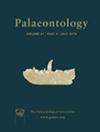An early Cambrian polyp reveals a potential anemone‐like ancestor for medusozoan cnidarians
IF 2.3
2区 地球科学
Q1 PALEONTOLOGY
引用次数: 1
Abstract
Cnidarians form a disparate phylum of animals and their diploblastic body plan represents a key step in animal evolution. Cnidarians are split into two main classes; anthozoans (sea anemones, corals) are benthic polyps, while medusozoans (hydroids, jellyfishes) generally have alternating life cycle stages of polyps and medusae. A sessile polyp is present in both groups and is widely regarded as the ancestral form of their last common ancestor. However, the nature and anatomy of the ancestral polyp, particularly of medusozoans, is controversial, owing to the divergent body plans of the extant lineages and the scarcity of medusozoan soft tissues in the fossil record. Here, we redescribe Conicula striata Luo & Hu from the early Cambrian Chengjiang biota, south China, which has previously been interpreted as a polyp, lophophorate or deuterostome. Through re‐examination of the holotype and 51 exceptionally preserved specimens, we show that C. striata possessed features of both anthozoans and medusozoan polyps. A conical, annulated organic skeleton (periderm) fully encasing a polyp is found in fossil and living medusozoans, while a tubular pharynx extending from the mouth into a gut partitioned by c. 28 mesenteries, resembling the actinopharynx of anthozoans. Our phylogenetic analyses recover C. striata as a stem‐group medusozoan, implying that the wealth of medusozoan diversity derived, ultimately, from an anemone‐like ancestor.早寒武纪水螅揭示了水母动物刺胞动物的潜在海葵祖先
刺胞动物形成了一个完全不同的动物门,它们的双胞体计划代表了动物进化的关键一步。刺胞动物分为两大类;珊瑚虫(海葵、珊瑚)是底栖珊瑚虫,而水母动物(水螅、水母)通常是珊瑚虫和水母交替的生命周期阶段。在这两个群体中都有一种无根息肉,并被广泛认为是它们最后共同祖先的祖先形式。然而,由于现存谱系的身体结构不同,并且化石记录中缺乏水母动物的软组织,因此,关于祖先水螅的性质和解剖结构,特别是水母动物的水螅,是有争议的。本文对中国南方早寒武世成江生物群中的Conicula striata Luo & Hu进行了重新描述,该生物以前被解释为水螅、磷藻或后口动物。通过对完整型和51个特殊保存标本的重新检查,我们发现纹状体同时具有珊瑚虫和水母的特征。在化石和活体水母动物中发现了一个圆锥形的、环状的有机骨架(表皮),完全包裹着息肉,而管状咽从口腔延伸到由约28个肠系膜隔开的肠道,类似于珊瑚虫的放射线咽。我们的系统发育分析恢复了纹海葵作为茎群水母动物的特征,这意味着丰富的水母动物多样性最终来源于类似海葵的祖先。
本文章由计算机程序翻译,如有差异,请以英文原文为准。
求助全文
约1分钟内获得全文
求助全文
来源期刊

Palaeontology
地学-古生物学
CiteScore
5.60
自引率
3.80%
发文量
43
审稿时长
6 months
期刊介绍:
Palaeontology publishes a wide variety of papers on palaeontological topics covering:
palaeozoology
palaeobotany
systematic studies
palaeoecology
micropalaeontology
palaeobiogeography
functional morphology
stratigraphy
taxonomy
taphonomy
palaeoenvironmental reconstruction
palaeoclimate analysis and biomineralization studies.
 求助内容:
求助内容: 应助结果提醒方式:
应助结果提醒方式:


